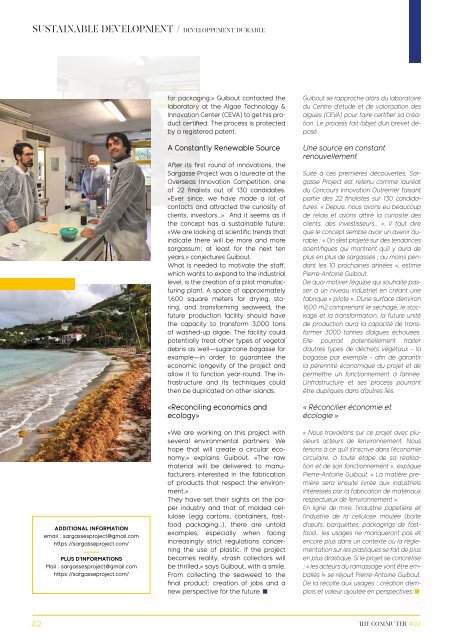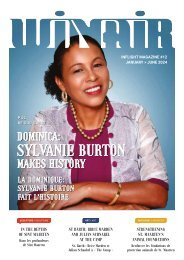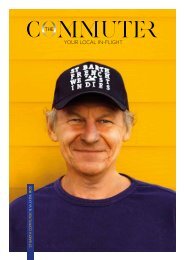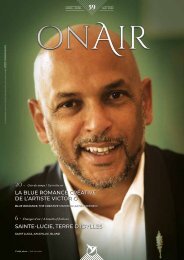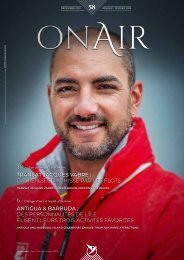Create successful ePaper yourself
Turn your PDF publications into a flip-book with our unique Google optimized e-Paper software.
SUSTAINABLE DEVELOPMENT / DEVELOPPEMENT DURABLE<br />
ADDITIONAL INFORMATION<br />
email : sargassesproject@gmail.com<br />
https://sargasseproject.com/<br />
PLUS D’INFORMATIONS<br />
Mail : sargassesproject@gmail.com<br />
https://sargasseproject.com/<br />
for packaging.» Guibout contacted the<br />
laboratory at the Algae Technology &<br />
Innovation Center (CEVA) to get his product<br />
certified. The process is protected<br />
by a registered patent.<br />
A Constantly Renewable Source<br />
After its first round of innovations, the<br />
Sargasse Project was a laureate at the<br />
Overseas Innovation Competition, one<br />
of 22 finalists out of 130 candidates.<br />
«Ever since, we have made a lot of<br />
contacts and attracted the curiosity of<br />
clients, investors…» And it seems as if<br />
the concept has a sustainable future:<br />
«We are looking at scientific trends that<br />
indicate there will be more and more<br />
sargassum; at least for the next ten<br />
years,» conjectures Guibout.<br />
What is needed to motivate the staff,<br />
which wants to expand to the industrial<br />
level, is the creation of a pilot manufacturing<br />
plant. A space of approximately<br />
1,600 square meters for drying, storing,<br />
and transforming seaweed, the<br />
future production facility should have<br />
the capacity to transform 3,000 tons<br />
of washed-up algae. The facility could<br />
potentially treat other types of vegetal<br />
debris as well—sugarcane bagasse for<br />
example—in order to guarantee the<br />
economic longevity of the project and<br />
allow it to function year-round. The infrastructure<br />
and its techniques could<br />
then be duplicated on other islands.<br />
«Reconciling economics and<br />
ecology»<br />
«We are working on this project with<br />
several environmental partners. We<br />
hope that will create a circular economy,»<br />
explains Guibout. «The raw<br />
material will be delivered to manufacturers<br />
interested in the fabrication<br />
of products that respect the environment.»<br />
They have set their sights on the paper<br />
industry and that of molded cellulose<br />
(egg cartons, containers, fastfood<br />
packaging…), there are untold<br />
examples, especially when facing<br />
increasingly strict regulations concerning<br />
the use of plastic. If the project<br />
becomes reality, «trash collectors will<br />
be thrilled,» says Guibout, with a smile.<br />
From collecting the seaweed to the<br />
final product: creation of jobs and a<br />
new perspective for the future.<br />
Guibout se rapproche alors du laboratoire<br />
du Centre d’étude et de valorisation des<br />
algues (CEVA) pour faire certifier sa création.<br />
Le process fait l’objet d’un brevet déposé.<br />
Une source en constant<br />
renouvellement<br />
Suite à ces premières découvertes, Sargasse<br />
Project est retenu comme lauréat<br />
du Concours Innovation Outremer faisant<br />
partie des 22 finalistes sur 130 candidatures.<br />
« Depuis, nous avons eu beaucoup<br />
de relais et avons attiré la curiosité des<br />
clients, des investisseurs… ». Il faut dire<br />
que le concept semble avoir un avenir durable<br />
: « On s’est projeté sur des tendances<br />
scientifiques qui montrent qu’il y aura de<br />
plus en plus de sargasses ; au moins pendant<br />
les 10 prochaines années », estime<br />
Pierre-Antoine Guibout.<br />
De quoi motiver l’équipe qui souhaite passer<br />
à un niveau industriel en créant une<br />
fabrique « pilote ». D’une surface d’environ<br />
1600 m2 comprenant le séchage, le stockage<br />
et la transformation, la future unité<br />
de production aura la capacité de transformer<br />
3000 tonnes d’algues échouées.<br />
Elle pourrait potentiellement traiter<br />
d’autres types de déchets végétaux - la<br />
bagasse par exemple - afin de garantir<br />
la pérennité économique du projet et de<br />
permettre un fonctionnement à l’année.<br />
L’infrastructure et ses process pourront<br />
être dupliqués dans d’autres îles.<br />
« Réconcilier économie et<br />
écologie »<br />
« Nous travaillons sur ce projet avec plusieurs<br />
acteurs de l’environnement. Nous<br />
tenons à ce qu’il s’inscrive dans l’économie<br />
circulaire, à toute étape de sa réalisation<br />
et de son fonctionnement », explique<br />
Pierre-Antoine Guibout. « La matière première<br />
sera ensuite livrée aux industriels<br />
intéressés par la fabrication de matériaux<br />
respectueux de l’environnement ».<br />
En ligne de mire, l’industrie papetière et<br />
l’industrie de la cellulose moulée (boite<br />
d’œufs, barquettes, packagings de fastfood…<br />
les usages ne manqueront pas et<br />
encore plus dans un contexte où la réglementation<br />
sur les plastiques se fait de plus<br />
en plus drastique. Si le projet se concrétise<br />
: « les acteurs du ramassage vont être emballés<br />
!» se réjouit Pierre-Antoine Guibout.<br />
De la récolte aux usages : création d’emplois<br />
et valeur ajoutée en perspectives.<br />
42 the commuteR #02


